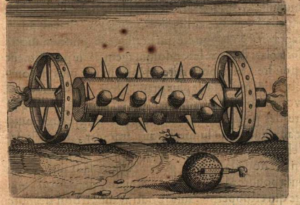I’ve blogged before about the use of exploding ships and other fireships in history here. But I’ve just found another interesting plan of combined exploding/fire ships in World War Two, a plan called Operation Lucid.
With a German invasion fleet massing around Calais and Boulogne, a series of pretty desperate measures were considered as methods of damaging the invasion fleet. Churchill, with his taste of history and knowledge of the fireships used against the Spanish Armarda, approved a plan put forward by Captain Augustus Agar VC. The plan involved two or three old oil tankers, filled with an incendiary mix and explosives to be steamed into the the large collection of German wooden invasion barges being collected at Calais and Boulogne. The incendiary mix , dubbed “Agar’s Special Mixture” consisted of 50% heavy fuel oil, 25% diesel oil, and 25% petroleum (gasoline). The explosive components consisted of unmeasured, but large, quantities of gun cotton, cordite and old sea mines.
Here’s a quote from one of the sailors assigned to the operation:
Chief Petty Officer Ronald Apps recalled:
In July 1940, I joined a Royal Fleet Auxiliary tanker – the War African – that was anchored off Sheerness for an idea that I have always assumed was thought up by Churchill. These tankers were filled up with fuel oil and there were mines and detonators down in the holds. The idea was that we would run them over to Boulogne and about five or six miles out of the harbour, we would set the controls and lash them – with the boilers going full bore – and run them into Boulogne harbour and let them blow up, to destroy the potential German invasion fleet. It was called Operation Lucid and we spent four weeks preparing. We practiced setting the controls and evacuating the ship with two speedboats alongside us which had been commandeered from Southend. These speedboats were remarkable things. They could go at 35 or 40 knots and the idea was that at the blowing of a whistle, we had to rush down, get in the boats and we were away. Those four weeks were a bit hairy because the tanker was full up with fuel oil when it came to us and it was primed and ready to explode and there were air raids at night. When you’re in a tanker, sitting on all this explosive material and the Germans are coming over and dropping bombs, it’s not very … shall I say ‘sleep inspiring’ experience. I got round to the idea that I had to sleep or I wouldn’t be able to walk around the next day.
In the end there were four attempts to launch the operation, but each failed for a variety of reasons, not least that the elderly ships adapted for the task were simply not reliable enough and kept breaking down. There are more details here.
There are some odd, almost spooky links between the operation’s commander, Agar VC, and previous blog posts I have written. Agar is a really interesting historic character. He had participated in the Zeebrugge raid in 1918 (link) and so was not new to the concept of the modern use of an explosively laden vessel. He was awarded the VC in mysterious circumstances because he was operating at the end of WW1 in support of SIS operations in Russia – running agents in and out of Bolshevik Russia using MTBs in the Baltic and other nefarious activities. As well as the VC he was also awarded the DSO. The DSO and the VC were awarded for two seperate motor torpoedo attacks on Bolshevik cruisers based on the island of Kronstadt (the site of this story in a previous blog).
I never imagined putting a link to a Daily Mail article on my blog, but this story here of the Baltic operations is worth breaking the rule.
The story of how he commanded HMS Dorsetshire, which was sunk under him by Japanese dive bombers in 1942, is also a remarkable story.

